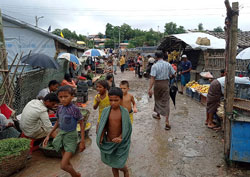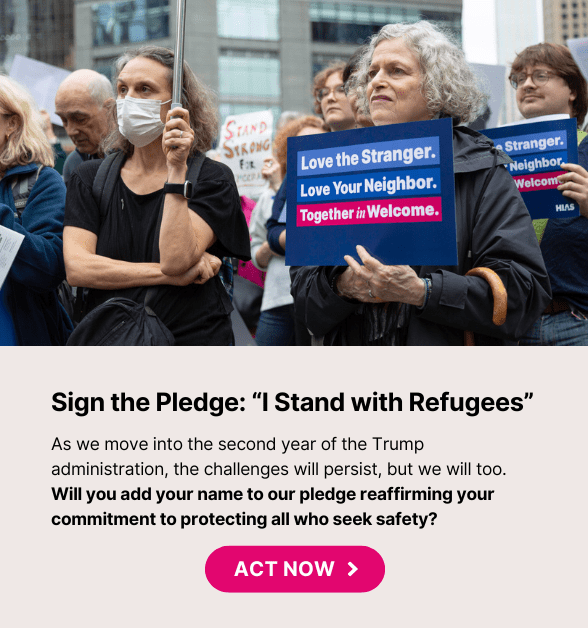Seeing Firsthand the Rohingya Refugee Crisis
By Naomi Steinberg, HIAS Senior Director, Policy and Advocacy
Dec 03, 2018
Prior to my trip to Bangladesh, I was not sure what to expect. I had been reading and talking about the ongoing forced displacement of the Rohingya for almost a decade, but this was going to be my first time learning firsthand about this crisis in Bangladesh.
For years, the Rohingya, a Muslim minority in predominantly Buddhist Myanmar, have been unrecognized. They are not citizens of any country. They are stateless. Their basic freedoms have been severely restricted, leaving them unable to work, worship, or even move from village to village as they wish.
In August 2017, more than 700,000 Rohingya fled a genocidal campaign at the hands of the Myanmarese military and militias. They left behind smoldering villages and murdered family members. They made their way to Cox’s Bazar District in one of the poorest corners of Bangladesh. There, they joined more than 300,000 other Rohingya refugees, some of whom have been there for decades, who had earlier been forced to flee the rampant persecution targeting their community. The expanded refugee camps in Southeastern Bangladesh now are, collectively, the largest in the world.
When I recently visited the camps in Bangladesh for HIAS, the drive from the city of Cox’s Bazar to the camps took just shy of two hours. It felt like driving through a kaleidoscope of color. To one side, is the Bay of Bengal and to the other are mountains looking down on rice fields that are so green they almost look unnatural. In front of us was a never-ending stream of rickshaws decorated in every shade of 80s- inspired neon.
When we finally arrived in the camps, I thought to myself that maybe this is what it was like being in IDP camps with Jews in Europe right after WWII. Or in the camps in Thailand right after the Khmer Rouge’s rampage in Cambodia. Or the camps in Uganda after the genocide in Rwanda. The list could go on.
One key difference between those crises and the current Rohingya crisis is that the survivors of those genocides, many of them at least, found new homes elsewhere. Rohingya refugees are not likely going anywhere any time soon, if ever. In spite of a flurry of renewed efforts between the governments of Bangladesh and Myanmar for Rohingya refugees to begin to return home, widespread repatriation cannot happen in the foreseeable future, and the doors to resettlement have largely slammed shut around the world.
Refugees with whom we spoke in the camps were very clear in saying that they want to go home someday, but they cannot do so until they can be assured of their safety and that they will have access to citizenship, neither of which can be promised at this time. I spoke to one Bengali man, very sympathetic to the refugees, and he simply said, “The Rohingya. They are our problem to die with.”
My trip to Bangladesh was organized by Humanity Rises, a humanitarian organization that is running a health clinic in the Balukhali camp in Cox’s Bazar. At the clinic, I spoke with two women at random. The first said that her husband was slaughtered at home in Rakhine State. She has five young children, all of whom were sick. In the immediate aftermath of the genocide refugees sought medical assistance because of injuries directly related to violence. They had stab wounds, burns and injuries borne from rape wielded as a weapon of war. Now this mother and her children were in line for treatment of skin and eye infections, respiratory illnesses, and gastrointestinal issues, ailments that come from living in overcrowded conditions. The second woman with whom I spoke said that back in Rakhine State her sister’s neck was sliced with a knife and then her young neice was thrown into a fire. These were the first two people with whom I spoke, so thinking of the number of others with similar stories is staggering.
The stories are horrifying, and the scope of the Rohingya refugee crisis is daunting. Nevertheless, we must speak out and help.
Last year the United States resettled only 22,491 refugees, while Bangladesh, one of the world’s most densely populated countries, has allowed more than one million refugees to find safety on its land. The imbalance and injustice of a world order in which this can happen is deeply upsetting.
We need to urge the United States to lead on Rohingya resettlement. While resettlement will never be the solution for the majority of any refugee population, including the Rohingya, it should be a lifesaving option for the most vulnerable of those for whom staying in Bangladesh is untenable and for whom repatriation to Myanmar is never going to be an option.
We should also encourage the U.S. government to urge the government of Bangladesh to allow Rohingya children to have access to formal education opportunities and for Rohingya adults to be able to work legally for as long as they must stay in Bangladesh.
Our elected officials must hear from us that the only true solution to this modern day genocide is addressing the root causes of Rohingya flight from Myanmar. The U.S. sanctions on a handful of military officials who helped to orchestrate the genocide is a step in the right direction. However, more must be done to pressure Myanmar to grant citizenship, freedom of movement, freedom of religion, and address the chronic rights violations that plague the Rohingya in Myanmar. Until and unless these steps are taken, it is impossible to envision a sustainable solution to this crisis.
The Rohingya refugee story, at its foundation, is based on religiously motivated genocide. Members of the American Jewish community have a particular voice and perspective to share. We can and should let decision makers know that we, as a community, want the United States to do more to ensure that the rights of Rohingya refugees, and those still in Myanmar, are respected.
A special public program on the Rohingya will take place Wednesday Dec. 5 at the U.S. Holocaust Memorial Museum.











